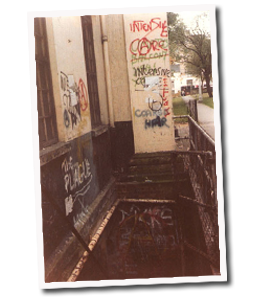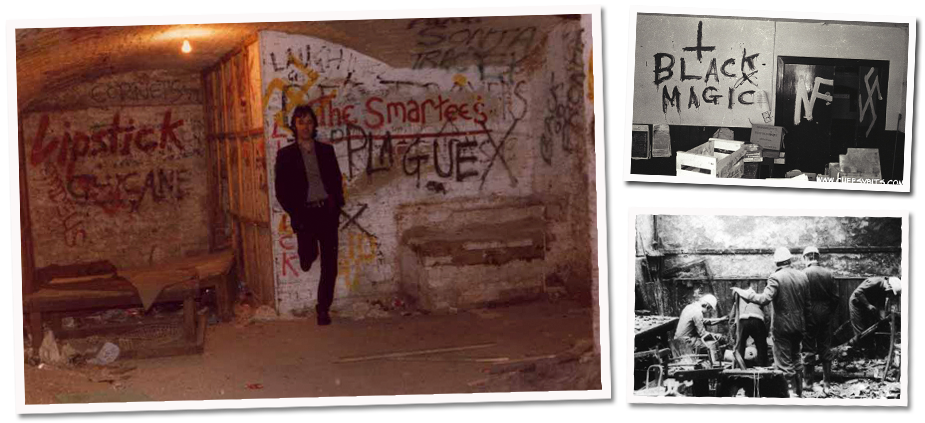|
|
|
|
"...The Vault made you feel dead even if you weren't..."
|
|
|
|
Situated beneath the Brighton Resource Centre in North Road, the Vault was originally a crypt beneath the old Presbyterian church. It was in fact a series of tombs, many of them intact until things got really out of hand during those, mad, bad times.
The Vault initially hosted gigs and must have been the nearest thing to the Liverpool Cavern Brighton is ever likely to see. Many bands played on the makeshift stage in the early days.
Gradually the Vault was given over to rehearsal spaces, divided up into seperate arches. The bands themselves got their sleeves rolled up and did a spot of bricklaying and labouring, building doorways and generally making use of
|
  |
the new-found space for individual rehearsal rooms
Security was non-existant and many arches had reinforced steel doors to try to stem the tide of constant break-ins.
Like a scene out of Blade Runner, several glue-sniffing punks who had nothing to do with the bands or the Resource Centre above, were dossing in former tombs and nobody quite knew how to deal with them.
Coffins were being smashed open and vandalised, the skull of a child was found in a nearby phonebox.
|
 |
|
|
|
Vault snaps
|
|
|
Clockwise below: Ken Hogg in the Vault. Ken played drums with Flesh, Parrots, Nicky & the Dots and April & The Fools, to name a few. He also designed the Vaultage album covers, famous for their depiction of the fate of the West
|
|
Pier. The Resource Centre after an attack by the National Front. Devastation after the fire.
Thanks to Dave Cheesybits and Kate from the Objeks for some of these photos
|
|
|
|
|
|
|
|
Attila the Stockbroker has a word...
|
|
|
Part One - Attila sent this in in 2005: I’m actually writing my autobiography at the moment, and in it there is a bit about the Vault and the first punk band I was in. So I thought I’d send it to you. Cheers, Attila.
"The seismic impact of punk rock had spread quickly all over the country, and by 1977 my hometown had its own thriving scene, based in The Vault. This was, as the name suggested, an old 19th century burial vault, situated in North Road under Brighton Resources Centre, which was the headquarters of the local punk/anarchist/squatter movement.
The Vault was simultaneously a rehearsal space and a gig venue, and all the early Brighton punk bands played there. On regular visits home from university to visit my mum and my friends and to watch my beloved Brighton and Hove Albion I had already seen three of Brighton’s first bands – Joby & The Hooligans, Wrist Action and the legendary Piranhas (whose legacy I would one day help to revive – but that was nearly 30 years later?)
|
|
Now it was time to heed Strummer’s call and get up there myself. Together with two Albion-supporting mates, Max Cooter (vocals) and Miles Baigent (guitar) we formed Brighton Riot Squad, and tried to find a drummer. But drummers were in very short supply. Then as now!
Even punk drummers were in short supply. You didn’t need to be able to play the drums very well, but you still needed to own or have access to a kit. In desperation, we stuck an advert in the local paper, and we got a call from Frank.
Frank claimed to be a drummer, and he did have a kit. He also had that other essential rock ‘n’ roll prerequisite – a car to drive his kit around in. Hooray! But when we met up for our first rehearsal, our glee was soon tempered by the realisation that having Frank in the band had three major disadvantages.
One: even by the more or less non-existent standards of punk, he couldn’t play the drums. A dead turbot had a better sense of rhythm.
|
|
Two: he had very dodgy right-wing views: his parents were refugees from somewhere in Eastern Europe, and the very sight of a red flag or the mention of the word ‘socialism’ made him go nuts. Three: he was a Teddy Boy.
The rivalry between Teds and punks in 1977 was media-created and of course blown up out of all proportion, but it did exist. Local Teds used to hang about outside the Vault looking for punks to beat up (for the painful results, listen to ‘Intensive Care’ by Brighton’s legendary Peter and the Test Tube Babies) and some punks were happy to return the compliment when the opportunity arose.
Soon word of our unorthodox line-up got around, and one of Brighton Riot Squad’s rehearsals in the Vault was noisily invaded by another punk band, the very young, very drunk, more or less all girl Molesters plus their hangers-on.
skip to Part Two
|
|
|
|
|
|
|
|
|
|
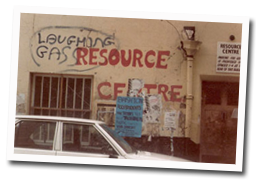
The Resource Centre
|
|
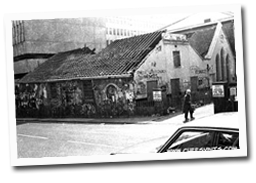
The Resource Centre after shutdown
|
|
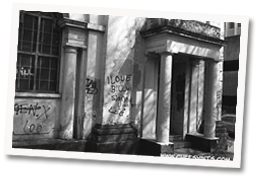
Entrance of the old Presbyterian Church
|
|
|
|
|
|
|
|
|
|
Attila Part Two
There was a developing problem. Before the punks had been let loose there, walls had been constructed in front of the actual burial chambers: the vibrations from rehearsals and gigs, plus general vandalism, caused breaches in them, and pretty soon skulls, bones and bits of coffin started turning up. Someone arrived at a gig with a skull they had found in a local telephone box.
Then whole coffins started to appear with still legible inscriptions, many with French names and plaques dating from the mid 1800s. Hugenot refugees, some having succumbed to some kind of plague - I distinctly remember one inscription ‘victime de la peste’.
This worried me! One evening I had volunteered to take the money on the door and on arrival the first thing I saw was a little baby’s lead coffin, about a foot long, with the bones still inside.
|
|
With due deference I moved the bones to one end and used the rest as a cashbox. If all this had happened ten years later I guess the Vault would have become the most popular Goth or death metal venue in the world – surely this was the very definition of death metal, or at the very least death punk - but there weren’t any Goths or death metallers then and many of us were actually rather uneasy about the whole thing.
Not just because it seemed a bit disrespectful: I remember sitting in the Three Jolly Butchers over the road having a discussion about exactly how long a plague bacillus could survive?!
Eventually, with skeletons quite literally coming out of the closet all the time, as it were, things got too much: the local council took action and the Vault’s doors closed for good.
When a ‘mysterious’ (fascist-perpetrated) fire
|
|
burned down the Resources Centre above, that colourful chapter in Brighton’s musical history came to an end, though it is preserved for posterity on two compilation albums, ‘Vaultage 78’ and ‘Vaultage 79’on Brighton’s seminal Attrix record label.
By then, however, I was playing bass in a punk rock band on the other side of the Channel, having met them through what was perhaps punk’s greatest achievement in the 1970s – the multicultural and truly international Rock Against Racism movement. And on September 8th 1980 I did my first gig as Attila the Stockbroker.

The young Attila
|
|
|
|
|
|
|
|
|

 back to top
This site is dedicated to the memory of Rick Blair
back to top
This site is dedicated to the memory of Rick Blair
The Punk History of Brighton © punkdaddy 2000 • 2015 • All Rights Reserved
|
|
|
